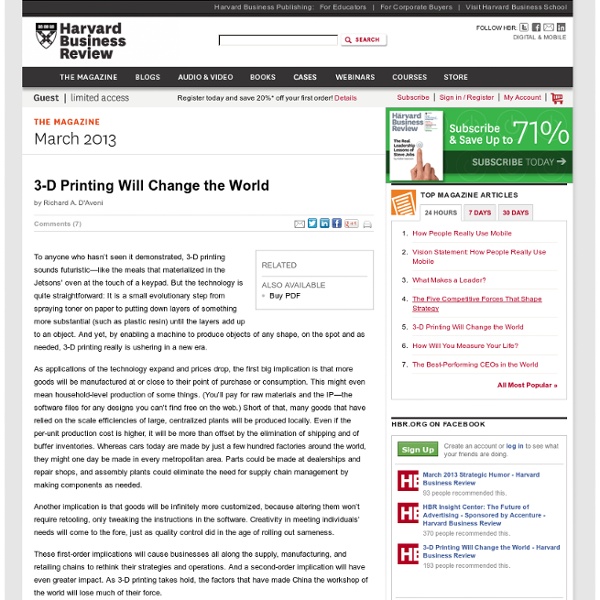3-D Printing Will Change the World
To anyone who hasn’t seen it demonstrated, 3-D printing sounds futuristic—like the meals that materialized in the Jetsons’ oven at the touch of a keypad. But the technology is quite straightforward: It is a small evolutionary step from spraying toner on paper to putting down layers of something more substantial (such as plastic resin) until the layers add up to an object. And yet, by enabling a machine to produce objects of any shape, on the spot and as needed, 3-D printing really is ushering in a new era. As applications of the technology expand and prices drop, the first big implication is that more goods will be manufactured at or close to their point of purchase or consumption. This might even mean household-level production of some things. Another implication is that goods will be infinitely more customized, because altering them won’t require retooling, only tweaking the instructions in the software.
Got a Kinect and a laptop? Get ready to 3D print
Volumental's vision is to be able to 3D print more or less anything you can see Image Gallery (7 images) Scanning and 3D printing an object could become much simpler if 3D printing company Volumental is successful in crowdfunding the development of a web app which would allow users to scan and print 3D objects using nothing more than a Kinect sensor and a web browser. View all Though the company already has a web service that allows people to upload scanned 3D models, Volumental says that it needs to refine an app which is better able to differentiate a thing (toys, pets, family members are among the suggestions) from its surroundings in order to be able to print the object in isolation. If funded, the app raises the exciting prospect of being able to scan more or less anything. Volumental is aiming to develop the app inside of three months. Though that sounds ambitious, Volumental is not a beginner in the field of 3D scanning. You can see the team's campaign video below. About the Author
Family07 back
Snowboard
Tiffy's glasses in the sun
Big Pictures
Primary purpose Summary Potential benefits Who can use the tool? What resources are needed? Development, ownership and support Third sector examples Further sources of information Footnotes The Big Picture Primary purpose The Big Picture is an organisational development framework for identifying the strengths and areas for improvement of an organisation across all of its activities. Each organisation can use The Big Picture in its own way to manage improvement, under the control of those who use the methods rather than an external evaluator. Top Summary Source: The Big Picture seeks to provide organisations with an approach that treats quality and impact issues in a holistic way. The approach suggests bringing as many people as possible together in a room. The Big Picture comes in the form of a workbook. Potential benefits Potential limitations Who can use The Big Picture? What resources are needed? Leadership Proficiencies or skills Staff time 1.
Government Surveillance: Cheaper and Deeper
Government Surveillance: Cheaper and Deeper Posted on Aug 24, 2012 Technical advancements and plunging costs for digital storage mean that government surveillance programs no longer have to be selective about the data they store. And with the average person leaving a trail of Web browsing, emails, text messages and more, there’s plenty of information that can be filed away on individuals. —Posted by Alexander Reed Kelly. The Caucus at The New York Times: John Villasenor, an electrical engineer at the University of California, Los Angeles, studied the plummeting cost of computer data storage and reached an astonishing conclusion: It will soon be technically feasible and affordable to record and store everything that can be recorded about what everyone in a country says or does. … Mr. More Below the Ad New and Improved Comments If you have trouble leaving a comment, review this help page.
Big Brother race row 'eviction'
19-year-old student Emily Parr is removed from the Big Brother household for using a racist word towards a housemate. At 9.30 this morning the Big Brother house was told that one of the contestants has been forced to leave. Emily Parr had used the word "nigger" last night while dancing with self-proclaimed "it" girl Charley Uchea in the living room. Within seven hours, she was gone from the household. Channel 4 said she had been heard to say: "Are you pushing it out, you nigger?" The exchange was not screened live and was immediately reported to senior production staff, according to Channel 4. Angela Jain, who heads the channel's Big Brother commissioning team, said in a statement: "She understands why her involvement in Big Brother has had to come to an end, and she very much regrets what she said." The incident comes in the wake of the last series of Celebrity Big Brother, when Indian actress Shilpa Shetty was racially abused by housemates.
Related:
Related:



